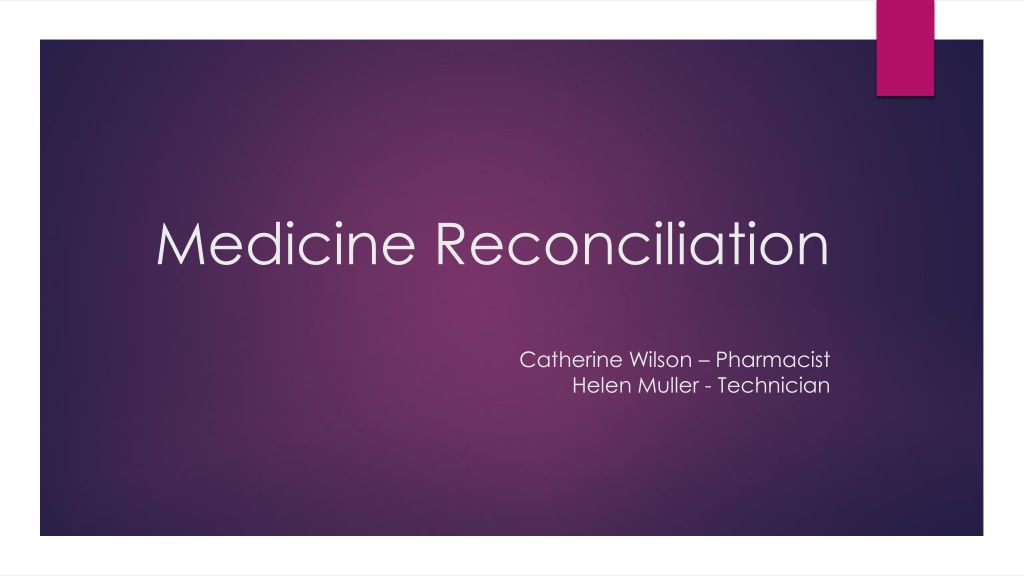

Replay
0 likes | 1 Views
Medicine reconciliation is a vital evidence-based process that involves collecting, comparing, and communicating accurate medication information to prevent errors. Changes in a patient's care setting can result in unintentional medication errors, emphasizing the need for accurate communication between healthcare professionals. Studies show high error rates in medication histories, with potential harm to patients. The process involves collecting information from multiple sources, comparing it to prescribed medication, and communicating any discrepancies to ensure patient safety.

E N D
Medicine Reconciliation Catherine Wilson – Pharmacist Helen Muller - Technician
Medicine reconciliation Medicine reconciliation is an evidence-based process, which has been demonstrated to significantly reduce medication errors caused by incomplete or insufficient documentation of medicine related information. It is the process of collecting, comparing and communicating the most accurate list of all medications, allergies and adverse drug reactions (ADRs) for a patient Any discrepancies are then documented and reconciled. A key to its success lies in accurate communication of medicine related information between healthcare practitioners.
Why do it? There are often changes to a patient's medicines when their care is handed over to other health professionals Examples include admission to hospital, transfer between wards or discharge from hospital. Some of these medicine changes are unintentional due to poor information and some are intentional but not clearly documented. Both types of change can result in medication errors and/or patient harm.
International studies Between 10 to 67 percent of medication histories have at least one error • Up to one-third of these errors have the potential to cause patient harm • More than 50 percent of medication errors occur at transitions of care • Patients with one or more medicines missing from their discharge information are 2.3 times more likely to be readmitted to hospital than those with correct information on discharge. • 85 percent of discrepancies in medication treatment originate from poor medication history taking • Medicine Reconciliation | Health Quality & Safety Commission (hqsc.govt.nz)
Medicine reconciliation standards www.hqsc.govt.nz/assets/Our-work/System-safety/Reducing- harm/Medicines/Publications-resources/Medication_Rec_Standard_v3.pdf
Steps Collect Compare Communicate
Collect Minimum of two sources A primary source will be one of the minimum sources used where possible. Talk to the patient (or their carer)! Consult and confirm with the patient the secondary and tertiary source information. Information provided by sources should cover at least a period of six weeks prior to the present day. Written sources of information should not be used if older than three months.
Sources of information Primary Verbal information from the patient, patient’s family/caregiver Patient held medication list eg. yellow card Patient’s own medicines as presented by the patient (noting date of supply and expiry date) • • • Secondary General practitioner’s information Community pharmacy’s information Community mental health team information Non-government organisations (NGOs) Aged residential care facility Lead maternity carers Other appropriate community health teams Clinical notes Current medication chart Transfer letters Hospital pharmacy records Previous reconciliation documentation • • • • • • • • • • • • Tertiary
Medicine details Medicine name (generic name) Medicine dose and units Frequency of administration Route(s) of administration If there are specified individualised times for the medicines to be administered Supplemental information to aid decision making eg. indication for PRN medicines, recently discontinued medicines, adherence issues.
Remember…. Inhalers, eye drops, creams etc Patients may not think of these as medicines Short courses of medicines such as antibiotics and steroids If a patient has their medicines with them – do they have the patient’s name on them, how old are they? Does the patient buy over the counter medicines? Do they use complementary/alternative medicines or Rongoa? There might be a difference between medicines prescribed, medicines dispensed, medicines taken
Some electronic sources of medicine histories at Waikato
Compare Compare the collected medicines, allergies and ADR list to the prescribed medicines, allergies and ADRs (at admission, transfer and discharge) to identify any differences.
Information to share with the pharmacist Any perceived medication errors Anything that could result in patient harm Anything the patient tells you that could cause harm Final medicines reconciliation form
Communicate Electronic or paper documentation Highlight the discrepancies Pharmacist to relay discrepancies to the prescribers
Medicine Reconciliation – an example Background from clinical notes: Post-surgical patient Tramadol commenced for pain Hypertension, AF and DVT/PE prophylaxis
NZePS Metoprolol succinate 95 mg CR tab, 1 tab daily – regularly dispensed Rivaroxaban 10 mg tablet, 1 tab daily – regularly dispensed Candesartan 8 mg tablet, 1 tab daily - regularly dispensed Paracetamol 500 mg tablets, 2 tablets QID – 1000 tablets in the last 3 months Triazolam 125 mcg tablets for sleep – 1 tablet nocte – 30
What the patient tells you…. Medications that patient actually takes Metoprolol succinate 95 mg CR tab, 1 tab mane Rivaroxaban 10 mg tablet, 1 tab nocte Candesartan 8 mg tablet, 1 tab mane Paracetamol 500 mg tablets, 2 tablets QID regularly for arthritis pain Triazolam 125 mcg tablets for sleep – takes half a tablet every night Aspirin 100 mg po daily – buys OTC St John’s Wort – buys OTC Thompson’s one a day, 4000 – would like to keep taking this Allergies: ACE inhibitors - cough
Other useful resources, references Jessica Nand and Dr Mark Beale talk about medicine reconciliation in NZ | Health Quality & Safety Commission (hqsc.govt.nz) Medicine Reconciliation | Health Quality & Safety Commission (hqsc.govt.nz) medication reconciliation video bmj learning
